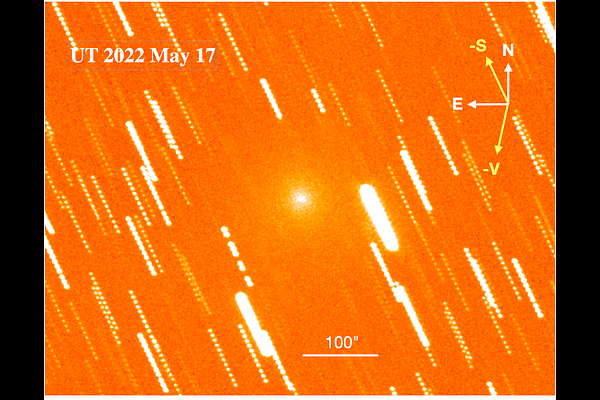Down But Not Out: The Case of Long-Period Comet C/2021 O3 (Panstarrs)

Down But Not Out: The Case of Long-Period Comet C/2021 O3 (Panstarrs)
David Jewitt. Jing Li, Michael Jaeger, Yoonyoung Kim
AbstractWe combine ground- and space-based observations of long-period comet C/2021 O3 (Panstarrs) (perihelion distance 0.287 au) in order to investigate its reported near-perihelion destruction. Pre-perihelion photometric observations show a remarkably small heliocentric dependence of the scattered light, $\propto r_H^{-s}$ with $s = 2.59\pm0.21$, distinct from values reported in other long-period comets, for which $s$ = 4 is the canonical standard. The index is smaller than expected of coma production by equilibrium sublimation of either supervolatiles (for which $s \sim$ 4 is expected), or water ice ($s \sim$ 6 to 8) across the $\sim$4 au to 2 au range. The absolute magnitude deduced from the pre-perihelion data is $H$ = 13.0$\pm$0.3 (coma scattering cross-section $\sim$225 km$^2$ for an assumed geometric albedo 0.04) while, after perihelion, the cross-section fades by a factor of 25 to $H$ = 16.5 ($\sim$9 km$^2$). STEREO spacecraft observations near perihelion show a long debris trail whose properties are consistent with forward scattering from radius $\sim$7 $\mu$m particles. The data show that the nucleus of C/2021 O3 was not destroyed at perihelion. Although the lightcurve from 3.9 au inbound to 0.8 au outbound cannot be uniquely interpreted, a simple and plausible explanation is provided by seasonal dimming on a nucleus having high obliquity and an asymmetric distribution of near-surface volatiles. The survival of the nucleus against rotational disruption suggests a pre-perihelion nucleus radius $r_n \gtrsim$ 1.0 km while the photometric limit to the radius of the nucleus after perihelion is $r_n < 1.7$ km (geometric albedo 0.04 assumed).